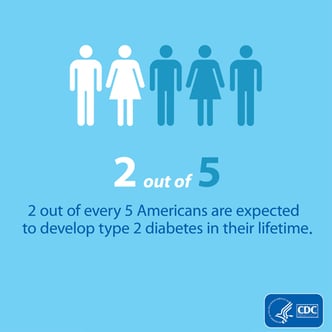November is National Diabetes Month, and we want you to know why it's a big deal. Each year, Healthcare foundations and organizations put a bat signal in the sky, asking for help to combat the rise of diabetes in America. Their goal is to help and educate folks at risk of developing diabetes and those with diabetes plan their course of action.
Organizations like the National Institute of Diabetes and Digestive and Kidney Diseases (NIDDK), American Diabetes Association (ADA), and the Centers for Disease Control and Prevention (CDC) are great resources for developing your plan to prevent or manage diabetes.
What is Diabetes?
So what is diabetes anyway? The CDC defines it as “a chronic (long-lasting) disease that affects how your body turns food into energy.” High levels of glucose is a result of the body’s difficulty making or using its own insulin well. Insulin is needed to help glucose move into the cells in order to convert blood sugar into energy. Uncontrolled high blood sugar leads to serious health complications and death. But with good blood sugar control, complications are largely preventable!.png?width=332&name=GLUCOSE%20(1).png)
Type 1 Diabetes
Type 1 can develop at any age but typically occurs among children and young adults. People with Type 1 Diabetes are not able to produce insulin because their immune system destroys the pancreatic beta cells that produce it. This can occur months after an illness. People with Type 1 Diabetes have to take insulin every day to stay alive.
Prediabetes
Prediabetes occurs when the blood sugar levels are higher than for a non-diabetic person, but not high enough to be considered diabetes. If lifestyle changes are not made, a person is more likely to progress to Type 2 Diabetes later on. The CDC says some of the signs and symptoms of Prediabetes are:
- Being overweight
- 45 years or older
- Having an immediate family member with Type 2 Diabetes
- Being physically inactive
- Previously having gestational diabetes
- Having polycystic ovary syndrome
Type 2 Diabetes
Type 2 is the most common type of diabetes and occurs mostly in middle-aged or older adults. However, the incidence of Type 2 Diabetes among children and adolescents has skyrocketed along with the increase in overweight and obesity, and less active lifestyles. In Type 2 Diabetes, the body has difficulty making enough insulin. About 90-95 percent of Type 2 Diabetes cases occur in adults.
This type of diabetes is commonly linked to lifestyle choices. Physical inactivity and obesity put a person at increased risk for Type 2. A family history of diabetes, previously having gestational diabetes, race, and high blood pressure are also risk factors for developing Type 2.
Gestational Diabetes
Gestational diabetes is a type of diabetes in pregnant women. This type typically goes away after giving birth, but about half of women who develop gestational diabetes go on to develop Type 2 Diabetes within the next few years. Keep in mind - Type 2 Diabetes is largely preventable with healthy lifestyle habits!
RELATED: National Diabetes Month: 30 Things You Need to Know About Diabetes

Quick Stats
- 2 out of every 5 Americans will develop Type 2 Diabetes during their lifetime
- Over 30 million Americans are diagnosed with diabetes
- A quarter of Americans don’t know they have diabetes
- Over 84 million Americans over the age of 18 have Prediabetes and are at risk of developing diabetes
- 90% of people with Prediabetes don’t know they have it
Diabetes, both Types 1 and 2, is a chronic disease with no cure. Neither type is “worse” than the other; neither type is “the bad kind.” They simply have different causes and treatments. But they are manageable! This means once developed, it will be a commitment to managing it. If diagnosed with diabetes, there are plenty of resources to support and guide a person through their journey. And don't fret - contrary to what you hear, Certified Diabetes Educator, Donna LaBrasca, says people with diabetes can eat pizza. But pump the brakes, not for every meal. See more of Donna's tips here.
Consult with your provider, a Certified Diabetes Educator, or Registered Dietician about how to develop a properly balanced meal plan that will work with their schedule and preferences.


